Pothos varieties are exceptionally adaptable houseplants. They have a great ability to adapt to different types of environments, making them one of the most popular houseplants.
Many people start out with a type of pothos plant because these houseplants are easy to grow and perfect for beginners.
Variety of Pothos Plants
The Pothos family of plants, botanically named the Epipremnum aureum, is an incredibly popular houseplant for a lot of reasons, not the least of which is that pothos plants are difficult to kill.
All types of pothos are very easy to grow and can be grown in almost any type of soil. They can manage in bright and low light conditions, drought-tolerant, and can even do well in low humidity.
The plant is also known for its beautiful foliage that adds beauty to your home or office space. It has an amazing ability to withstand dry conditions, and it will thrive even if you don’t water it regularly.
They are also incredibly easy houseplants to propagate with stem cuttings.
They are vining plants that like to have its vines cascade down from hanging baskets, or perched high on shelves or furniture. The vines of green leaves can climb up a pole or trellis, or be pruned into a bushy stand-up plant on a tabletop.
Let’s look at several of the top, popular pothos types to cultivate in your indoor garden.
1. Golden Pothos
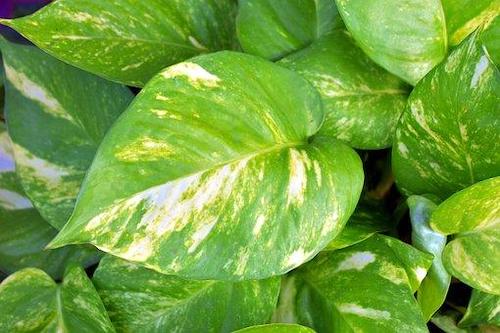
The Golden Pothos, also called Devil’s Ivy, is the most common and recognizable pothos variety. Sometimes, “golden pothos” will be the term that’s used to the whole species of pothos as well.
This popular variety has bright, medium-green variegated leaves with streaks, and splashes of yellow and gold. The golden variegation is loved by many.
Read the in-depth Golden Pothos Care Guide.
2. Cebu Blue Pothos
Technically this is a different species called the Epipremnum pinnatum but it behaves just like the Epipremnum aureum.
If environmental conditions are sunnier and warmer, the foliage will increase in size. They have arrow-shaped leaves with a bluish-green tint.
Unlike other pothos varieties, its foliage may develop perforations or cuts known as fenestrations, making it behave more like a Monstera.
Learn about the Cebu Blue Pothos.
3. Jessenia Pothos
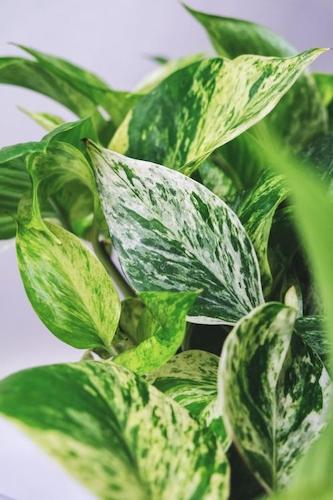
Jessenia has much in common with the Marble Queen and Manjula varieties of pothos, especially when it comes to the shape and size of its foliage.
A mixture of many varied shades of dark green and yellow variegation, no two leaves will look alike, and layer upon layer gives it its unique and fascinating appearance.
It will also grow more slowly due to a lesser amount of chlorophyll in foliage. Although the Jessenia may somewhat resemble the Marble Queen, its coloration will be darker in hue.
Learn more about the Jessenia Pothos and how to care for it.
4. Manjula Pothos

Large heart-shaped leaves characterize the Manjula Pothos, a patented pothos cultivar. This is a very slow-growing pothos variety.
The leaves are usually variegated with green, cream, and white patches. It can also have the marbled look that’s typical of other pothos varieties. Thanks to the larger size of foliage, it is often grown as a stand-up plant.
The Manjula foliage distinguishes itself among pothos varieties because its leaf edges tend to curl. White patches may also appear to be freckled with green.
Learn more about Manjula Pothos Care.
5. Marble Queen Pothos
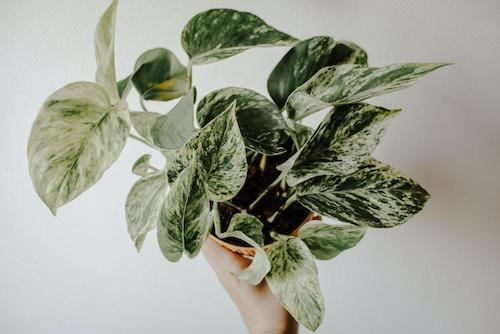
The Marble Queen Pothos is a royal variety of the pothos boasting deep dark glossy foliage, marbled with streaks of creamy white that distinguish it.
If it is kept in bright but indirect light, leaves will maintain these characteristics. Should you locate it in a low light spot, its green variegation will diminish, favoring the darker green hue.
The marble queen variety has a slower growth rate because it contains less chlorophyll due to a large amount of variegation than a Neon or a Golden, but it offers refined, delicate elegance to any location.
Read about Marble Queen Pothos Care.
6. N-Joy Pothos
The N-Joy Pothos is a newer cultivar of these indoor plants. Foliage is green but variegated heavily with large amounts of white interspersed.
If you like the white variegated varieties, you can encourage their growth by keeping the N-Joy pothos in very bright conditions. This pothos is just as easy as others to cultivate, and it is also a slow grower, so be patient!
Learn about the N-Joy Pothos and caring for it. Also check out this Pothos N Joy vs Pearls and Jade comparison.
7. Neon Pothos
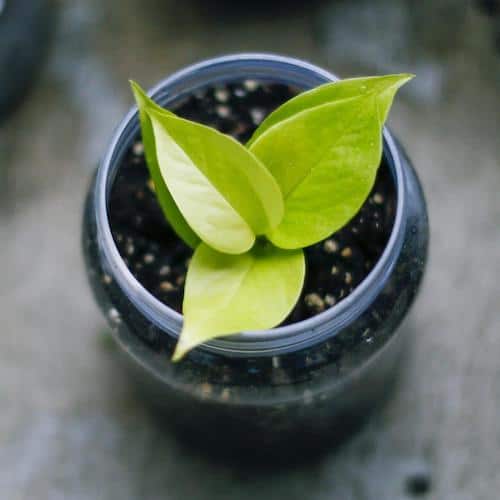
If you love bright colors, including bright lime hues, the Neon Pothos may be the variety for you.
The foliage resembles a shade of bright chartreuse, especially when young. As it matures, its green foliage will turn to a lighter green color with age.
If it receives light that is too bright, its vivid colors may also fade somewhat, whereas with too little light it may appear pale. It’ll be a balance of finding the right light conditions, but to encourage the neon appearance, exposure to bright light is necessary.
Learn more about Caring for the Neon Pothos Plant.
8. Pearls and Jade Pothos
Interestingly enough, the Pearls and Jade Pothos was developed by the University of Florida, so it’s a patented variety by them.
It features white and creamy variegation that forms larger, more irregular patterns across the foliage.
The white sections will be more at risk of sunburn and scorching, so while this pothos enjoys light, it needs to be indirect. You can accomplish this by placing it near but not on a windowsill or behind sheer curtains to protect it.
Leaves tend to be somewhat smaller than other varieties, and they are slow growers.
Read more in-depth about the Pearls and Jade Pothos.
9. Silver Satin Pothos
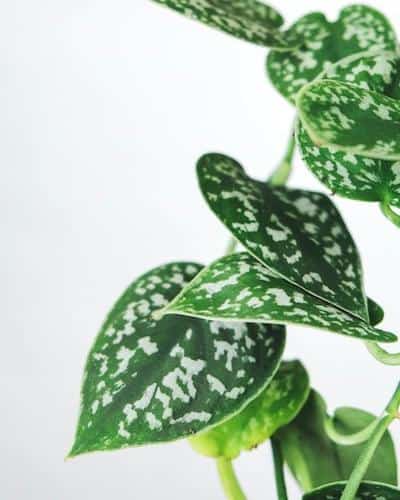
Silver Pothos are a beautiful and original pothos variety that boasts smaller-sized, blue-green leaves, and with a silvery and unique leaf pattern.
Botanically name the Scindapsus pictus, these are perfect to grow in hanging baskets or pots on high shelves. The pothos leaves will trail downward and spill over the edges beautifully.
To keep the silver flecks silver, give it lots of bright indirect light.
Read the in-depth guide to Silver Satin Pothos Care.
10. Snow Queen Pothos
The Epipremnum aureum “Snow Queen” features striking white patterns on its leaves.
The principal difference with the Marble Queen Pothos is that the white variegation is more pronounced in the snow queen pothos. The white in the marble queen is paler.
Learn more about the similarities and differences in this article: Snow Queen vs Marble Queen Pothos Plants.
How To Care for Your Pothos
These houseplants are usually indicated for beginner gardeners because they are incredibly adaptable and not really very fussy.
They can manage and thrive in both low light and very bright indirect light. Direct sunlight can scorch leaves.
Your growing medium should be a good quality potting mix that’s well-draining. Let the soil dry out somewhat in between waterings.
When the foliage begins to droop a bit, you’ll know your pothos is thirsty.
Different pothos varieties will have specific growing needs, but here are the key things to keep in mind for general pothos care:
Light: Bright indirect light is the preferred lighting condition for healthy pothos growth.
Water: Let the soil bed dry out in between watering. It will manage if you forget to water occasionally. Just don’t make it a habit. As soon as the foliage droops, give your plant a drink.
Soil: Standard, good quality potting mix is fine, as long as it drains well. You can add in a bit of perlite to guarantee drainage. The ideal pH level will measure between 6.1 and 6.5, slightly acidic. The pothos can also be cultivated in water.
Fertilizer: This houseplant is not a big feeder, so there’s no need for regular feedings. You can use a basic liquid houseplant fertilizer four times a year or every 3 months. Do not over-fertilize these plants.
Temperature: These tropical plants like warmer environments with temperatures ranging between 70° and 90° Fahrenheit. It can adapt to lower temps, but will suffer if they drop below 55°F.
Propagation: Take a stem cutting and place it either in potting soil or in a jar of water to propagate.
Pothos Varieties Final Thoughts
Pothos are easy to grow and maintain and provide an attractive addition to any home or office. They are great for beginners who want to learn how to take care of their own houseplants.
There are many different types of pothos available today. Some are more compact and others are larger, some are single flowered and others are double flowered.
There are even some that come in colors besides green!
Pothos Varieties FAQs
How many pothos varieties are there?
There are dozens of different types of pothos plants, and they come in a wide variety of colors, shapes, sizes, and textures. Pothos are easy to grow and require little maintenance, making them perfect for beginners who want to start growing something new in their homes.
Which is better, pothos or philodendron?
Pothos plants are better in that they are easier to grow than philodendron plants. Both the pothos and philodendron are still easy to grow, but the pothos is more flexible with its care needs. Pothos are more tolerant with water and lighting conditions, if they are neglected for a little time.
Are giant pothos different from regular pothos?
Giant pothos are much bigger than regular pothos, and they grow up to about 30 inches tall. They prefer bright light and moist soil conditions. The leaves look like they are made out of leather, which helps them absorb water. If you’re interested in growing giant pothos, then you should plant them in large pots with rich, well-drained soil. You’ll need to water the giant pothos more as well, especially when it’s younger.
Why is pothos called devil’s ivy?
Pothos are called devil’s ivy, because it’s very difficult to kill. You can neglect it for a long time, but it will survive. It’ll grow slowly with neglect and no light, so if you want it to grow, give it some water and bright indirect light.
Why did my pothos plants develop spikes?
The spikes on pothos plants are usually new growth on the plant, especially after propagation from leaf cutting. These are new aerial roots sprouting on the stem.

